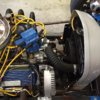I purchased a new water pump even though it looked good. I checked for blockages but did not detect any. The radiator, transmission cooling lines, engine accessories and brackets have been removed. I called Ron Pope this morning and ordered an aluminum radiator that mimics the '66 mustang specifications. A shroud will be added and furbished with a bigger fan.
I pondered some of my earlier decisions during the build last night and in hindsight I should have fixed one of them. One of them was the brass radiator outlet location. Not sure if this is contributing to the overheating issue but the radiator in question has the bottom hose port on the passenger side. The engine pump inlet is on the driver's side. I had to piece two hose sections to a radius'd steel pipe section to make it work. As you may imagine the hose looks real "snaky". Again, not sure if this extra travel and articulated bend is causing the cooling system to be less effective but for the life of me I cant understand why the cooler (150 F) fluid at the bottom of the rad isn't cooling the engine. In any event, the new radiator will have the bottom outlet on the correct side.
I've always been a proponent of making one change at a time to determine root cause but in this case things are moving in a direction where more than one issue needs to be addressed at the same time.
Not sure that I can do anything else until the rad arrives next week. If there is anything you think I ought to investigate in the meantime, please let me know.
Thanks





